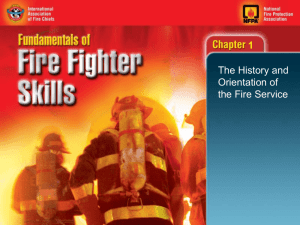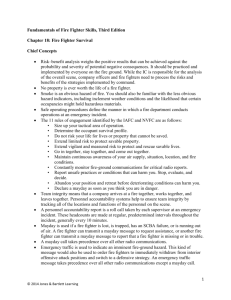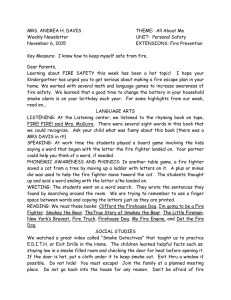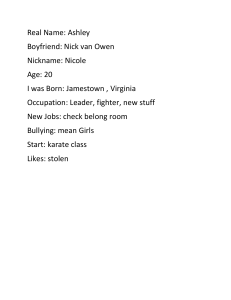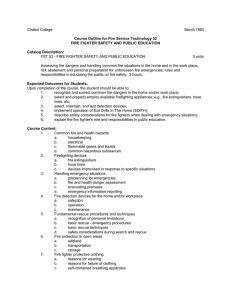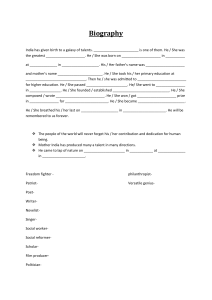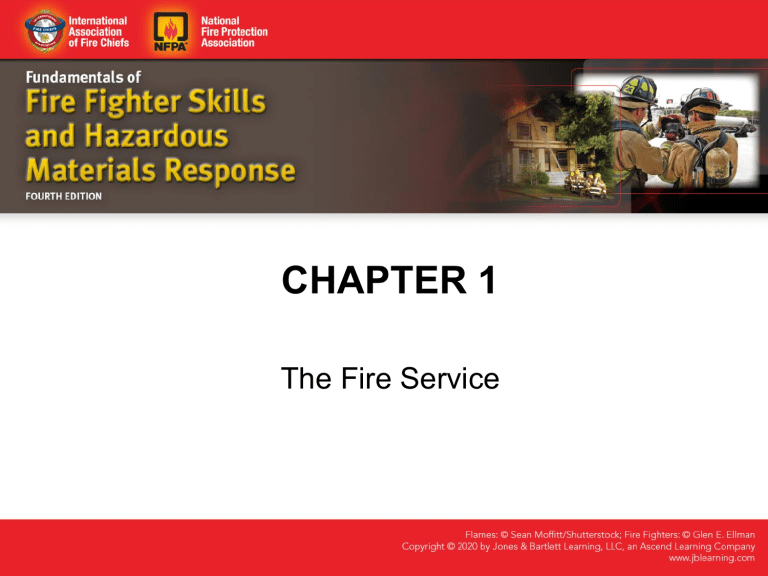
CHAPTER 1 The Fire Service Knowledge Objectives • List five guidelines for successful fire fighter training. • Describe the mission of the fire service. • Describe the culture of the fire service. • Describe the general qualifications for becoming a fire fighter. • Outline the roles and responsibilities of a Fire Fighter I. Knowledge Objectives • Describe the common roles of fire fighters within the fire department. • Describe the specialized response roles within the fire department. • List the Five Es of community risk reduction. • Describe the characteristics of a Community Risk Reduction (CRR) program. • Identify common safety hazards in the home. Knowledge Objectives • Describe the basic types of residential smoke alarms. • Describe a situation in which you will interact with other organizations within your community. • Explain the concept of governance, and describe how regulations, standards, policies, and standard operating procedures affect it. • Locate information in departmental documents and standard operating procedures. Knowledge Objectives • Describe the organization of the fire service. – List the different types of fire department companies, and describe their functions. – Describe how to organize a fire department in terms of staffing, function, and geography. – Explain the basic structure of the chain of command within the fire department. – Define the four basic management principles used to maintain organization within the fire department. • Explain the evolution of the methods and tools of firefighting from colonial days to the present. Knowledge Objectives • Explain how building codes prevent the loss of life and property. • Describe the evolution of training and education for fire department services. • Describe the evolution of fire equipment for fire department services. • Describe the evolution of communications for fire department services. • Describe the evolution of funding for fire department services. Introduction • Training to become a fire fighter is not easy. • Fire fighters are challenged both physically and mentally. • Fire fighter training will expand your understanding of fire suppression. Fire Fighter Guidelines • • • • • Be safe. Follow orders. Work as a team. Think! Follow the Golden Rule. The Mission of the Fire Service • Primary mission – To save lives and protect property and the environment through: • • • • Prevention Education Suppression Rescue activities The Mission of the Fire Service • Mission statement – Should be short enough that you can easily remember it – May post it in a visible place where it will be seen regularly The Culture of the Fire Service • Understanding the culture of the fire service helps you better understand its values. • Cultural characteristics of the fire service – – – – – – – Courage Honor Duty Respect Integrity Character Moral courage Fire Fighter Qualifications • Age requirements – Must be at least 18 or 21 for most fire departments – Differ for volunteer fire departments • Education requirements © Jones & Bartlett Learning. Photographed by Glen E. Ellman. – Minimum of high school diploma or equivalent for most fire departments Fire Fighter Qualifications • Medical requirements – Medical evaluations are often required before training can begin. – Medical requirements for fire fighters are specified in NFPA 1582, Standard on Comprehensive Operational Medical Program for Fire Departments. Fire Fighter Qualifications • Physical fitness requirements – Firefighting requires strength and stamina. – Candidate Physical Ability Test (CPAT) scenarios • • • • • • • • Stair climb Ladder raise and extension Hose drag Equipment carry Forcible entry Search Rescue Ceiling breach and pull Fire Fighter Qualifications • Emergency medical care requirements – Fire fighters may be required to be certified as: • • • • Emergency Medical Responder (EMR) Emergency Medical Technician (EMT) Advanced Emergency Medical Technician (AEMT) Paramedic Fire Fighter Qualifications • Testing and interview requirements – Steps in the application process are decided by each fire department. – Screening processes commonly consist of: • Written exam • Oral interview Roles and Responsibilities for Fire Fighter I • Don and doff personal protective equipment (PPE) properly. • Hoist hand tools using appropriate ropes and knots. • Understand and correctly apply appropriate communication protocols. • Use self-contained breathing apparatus (SCBA). • Respond on apparatus to an emergency scene. Roles and Responsibilities for Fire Fighter I • Establish and operate safely in emergency work areas. • Force entry into a structure. • Exit a hazardous area safely as a team. • Set up and use ground ladders safely and correctly. • Attack a passenger vehicle fire, an exterior Class A fire, and an interior structure fire. Roles and Responsibilities for Fire Fighter I • • • • Conduct search and rescue in a structure. Perform ventilation of an involved structure. Overhaul a fire scene. Conserve property with salvage tools and equipment. • Connect a fire department engine to a water supply. • Extinguish incipient Class A, Class B, and Class C fires. Roles and Responsibilities for Fire Fighter I • • • • • • Illuminate an emergency scene. Turn off utilities. Combat ground cover fires. Perform fire safety surveys. Clean and maintain equipment. Locate information in departmental documents and standard operating procedures. • Operate as part of a team. Roles and Responsibilities for Fire Fighter II • Perform scene size-up. • Determine the need for the incident command system (ICS). • Arrange and coordinate ICS until command is transferred. • Prepare reports. • Communicate the need for assistance. Roles and Responsibilities for Fire Fighter II • • • • • Coordinate an interior attack line team. Extinguish an ignitable liquid fire. Control a flammable gas cylinder fire. Protect evidence of fire cause and origin. Assess and disentangle victims from motor vehicle accidents. • Assist special rescue team operations. Roles and Responsibilities for Fire Fighter II • Perform a fire safety survey. • Present fire safety information. • Maintain fire equipment. • Perform annual service tests on fire hose. Courtesy of Marsha Giesler. Roles Within the Fire Department • • • • • • • • Fire apparatus driver/operator Company officer Incident safety officer Training officer Incident commander (IC) Fire marshal Fire inspector Fire investigator Roles Within the Fire Department • • • • • • • Fire and life safety educator (FLSE) 911 dispatcher/telecommunicator Emergency vehicle technician (EVT) Fire police officer Information management Public information officer (PIO) Fire protection engineer Specialized Response Roles • • • • • Aircraft/crash rescue fire fighter (ARFF) Hazardous materials (“Hazmat”) technician Technical rescuer (“Tech rescuer”) SCUBA dive rescue technician Emergency Medical Services (EMS) personnel – – – – Emergency Medical Responder (EMR) Emergency Medical Technician (EMT) Advanced Emergency Medical Technician (AEMT) Paramedic Working Within the Community • Community Risk Reduction (CRR) – Comprehensive, all-hazard, unifying approach – Includes programs, actions, and services used by a community, which prevent or mitigate the loss of life, property, and resources – Began in England – Gaining momentum in the United States Working Within the Community • Six basic steps of risk reduction – – – – – – Identify risks. Prioritize risks. Develop strategies and tactics to mitigate risks. Prepare the CRR plan. Implement the CRR plan. Monitor, evaluate, and modify the plan. Working Within the Community • Examine risks through the lens of the Five Es of fire prevention – – – – – Education Engineering Enforcement Economic incentives Emergency response Educating the Public about the Risks • Many departments conduct fire and life safety surveys. • Simple precautions to prevent emergencies – Properly enclosing pools – Properly securing furniture, televisions, and appliances to prevent tip-overs – Storing medicines and chemicals where children cannot access them – Use of handrails and guards on stairs and balconies – Keeping residential hot water below 120°F (49°C) Educating the Public about the Risks • During the survey – – – – Point out hazards. Explain the reasons for making recommendations. Answer any questions the occupants may have. Look for and address dangers related to: • Functioning fire protection equipment • Ignition sources near combustible materials • Fireplaces, wood stoves, and portable heaters Educating the Public about the Risks • Conduct the survey in a systematic fashion. • Explain the importance of good housekeeping. • Gasoline and flammable liquids should be stored only in approved containers and in outside storage areas or outbuildings. • Listen carefully to the occupants. • After the survey, file your report according to your department’s policies. Residential Smoke Alarms • Single-station smoke alarm – Most common residential fire alarm – May be battery-powered, hard-wired, or both • NFPA 72, National Fire Alarm and Signaling Code – Recommends replacing smoke alarms 10 years after the date of manufacture Courtesy of Kidde Residential and Commercial Division Residential Smoke Alarms • Ionization alarms – Activated by smaller, invisible products of combustion – React more quickly to fast-burning fires – More susceptible to nuisance alarms from common activities © Brendan Byrne/age fotostock Residential Smoke Alarms • Photoelectric alarms – Activated by the larger, visible products of combustion – More responsive to slowburning or smoldering fires – Less prone to false alarms from steam © Serov Aleksei/Shutterstock, Inc. Residential Smoke Alarms • Combination ionization and photoelectric alarms are available. Courtesy of Kidde Fire Safety Residential Smoke Alarms • Remind homeowners to: – Test alarms every month. – Change alkaline batteries in smoke detectors. – Replace all smoke alarms • Every 10 years • Whenever they fail the monthly test – Clean smoke alarms regularly. Working with Other Organizations • Fire departments need to interact with other organizations in the community. Working with Other Organizations • Incident command system (ICS) – – – – – Unified command system Controls multiple agencies at an incident Eliminates multiple command posts Establishes a single set of goals and objectives Ensures mutual communication and cooperation Working with Other Organizations • Large-scale incidents may require calling on: – – – – – – – – – – Public works School administrators Funeral directors Government officials Federal Bureau of Investigation Military Emergency management agencies Search and rescue teams Fire investigators Various state agencies Fire Department Governance • Governance – Process by which an organization: • Exercises authority • Performs functions assigned to it • Regulations – Detailed rules that implement a law passed by a governmental body • Standards – Issued by nongovernmental entities – Generally consensus based Fire Department Governance • Standard operating procedures (SOPs) – Provide specific information on actions that should be taken to accomplish a certain task • Standard operating guidelines (SOGs) – Not as strict as SOPs – Conditions may dictate that the fire fighter or officer uses his or her personal judgment. © Jones & Bartlett Learning Fire Department Governance • Truck company © Jones & Bartlett Learning. Photographed by Glen E. Ellman. • Engine company © Jones & Bartlett Learning. Photographed by Glen E. Ellman. Company Types Company Types • Rescue company • Wildland/brush company • Hazardous materials company • Emergency medical services (EMS) company © Jones & Bartlett Learning. Photographed by Glen E. Ellman. Additional Apparatus • Quint apparatus • Initial attack apparatus • Mobile water supply apparatus Other Views of Fire Service Organization • Staffing – Departments must have sufficient trained personnel available. • Function – Departments can be organized by function. • Geography – Departments are responsible for distinct geographic areas. • Creates a structure for managing the department and the fire-ground operations • Ranks may vary by department, but the concept is the same. © Jones & Bartlett Learning Chain of Command Source of Authority • Fire departments may derive their authority from: – Local governments – State governments – Federal government • Fire chief – Accountable to the governing body Basic Principles of Organization • Discipline – Guiding and directing fire fighters – Includes positive and negative discipline • Division of labor – Makes individual responsible for completing the assigned task – Prevents duplicate job assignments Basic Principles of Organization • Unity of command – Establishes a direct route of responsibility from the chief to the fire fighter © Jones & Bartlett Learning Basic Principles of Organization • Span of control – Number of people one person can supervise effectively – FEMA states that the span of control of personnel is between 3 and 7. • May be lower in complex or rapidly changing environments History of the Fire Service • Concerns with fire protection can be traced to Roman times. – Familia Publica • First fire department • Established by Augustus Caesar in 24 B.C. • Composed of slaves stationed around the city – Corps of Vigiles • Established in 60 A.D. • Responsible for firefighting, fire prevention, and building inspections History of the Fire Service • The American fire service – First documented structure fire in North America • Jamestown, Virginia in 1607 – First fire regulations in North America • Boston in 1630 – First paid fire department in the United States • Boston in 1679 – First volunteer fire department in the United States • Philadelphia in 1735 The Great Chicago Fire • • • • Began October 8, 1871 Burned for 3 days 2000 acres burned Damage totals: – – – – 17,000 homes destroyed $200 million in damage 300 dead 90,000 homeless The Peshtigo Fire • Flash forest fire occurred at same time as the Great Chicago Fire – – – – “Tornado of fire” 1000 ft high and 5 miles wide More than 2400 square miles of forest land burned More than 1200 dead Several small communities destroyed Iroquois Theater Fire • • • • December 30, 1903 in Chicago, Illinois 602 deaths Worst single building fire in American history Resulted in changes for theaters, including: – – – – – Exit lighting Automatic sprinklers Standpipes Fire alarms Flame-resistant scenery, props, and curtains Triangle Shirtwaist Factory Fire • • • • March of 1911 in Manhattan, New York 146 deaths Precursor for NFPA 101, Life Safety Code Led to changes such as: – Installation of enclosed stairways and elevators with fireproof shafts – Sprinkler systems in buildings where more than 25 people work above ground level – Escape routes – Outward opening doors that remain unlocked Cocoanut Grove Fire • Boston, Massachusetts in 1942 • 492 deaths • Led to changes, including: – Adding nightclubs to the definition of public places – Requiring: • Number and width of exits to be adequate for occupancy • Revolving doors to be flanked by standard exit doors • Materials used as decorations in places of public assembly to meet flammability standards • Permanent emergency lighting that operates independently of other lighting failures Our Lady of the Angels School Fire • Chicago, Illinois in 1958 • 95 deaths, including 92 children • Led to changes including the requirements that: – Schools must be equipped with automatic building alarm systems. – A full first alarm response must be made to all school alarms. – Schoolroom occupancy must be limited. – School personnel must be trained in fire safety. The Beverly Hills Supper Club Fire • Southgate, Kentucky in 1977 • 165 deaths • Triggered requirements for automatic sprinklers and fire alarm systems in new and existing assembly occupancies when the number of occupants exceeds 300 The MGM Grand Hotel Fire • Las Vegas, Nevada in 1980 • 85 deaths • Catalyst for Nevada to update fire codes and retrofit fire sprinkler systems – Initial opposition to retrofitting disappeared when another Las Vegas hotel fire killed eight people the next year. The Station Nightclub Fire • Warwick, Rhode Island in 2003 • 100 deaths • Led to tentative interim amendments (TIAs) that were later approved for the 2006 Life Safety Code, including new rules regarding: – – – – Festival seating Crowd managers Automatic sprinkler protection Means of egress inspections Building Codes • History of building codes – Egyptians used codes to prevent collapse. – Colonial communities had few codes. – Today’s codes address construction materials and “built-in” protection. Modern Code Development • Codes are written by national organizations. – National Fire Protection Association (NFPA) – ICC • Volunteer committees research and develop proposals for debate and review. Training and Education • Today’s fire fighters operate high-tech, costly equipment. • Fire fighters need to continually sharpen their skills and increase their knowledge. © Jones & Bartlett Learning. Courtesy of MIEMSS. Certification • Offered by two national organizations – National Board on Fire Service Professional Qualifications (Pro Board®) – The International Fire Service Accreditation Congress (IFSAC) • Available at all levels of the fire and emergency services Fire Equipment • Colonial fire fighters had buckets, ladders, and fire hooks. • Hand-powered pumpers – Developed in 1720 in London, England • Steam-powered pumpers – Developed in 1829 Fire Equipment • Present-day equipment – Single apparatus used for several purposes • Fire hydrants – Developed in New York City in 1817 • Public call boxes – Developed in Washington, D.C. in 1860 Communications • Colonial period – Fire wardens and night watchmen • Late 1800s – Telegraph alarm systems • Present day – Hard-wired and cellular telephones – Computer-aided dispatch facilities Fire-Ground Communications • Early days © Jones & Bartlett Learning. – Chief officers used trumpets to amplify their voices to give commands. Fire-Ground Communications • The inclusion of multiple trumpets on the chief’s badge today symbolizes the rank of chief. © Jones & Bartlett Learning. Photographed by Glen E. Ellman. Fire-Ground Communications • Present day – – – – Two-way radios Voice amplification system SCBA alarms PASS devices Paying for Fire Service • Volunteer fire departments – Common in colonial America – Still used today in many areas • First fire wardens – Employed by communities – Paid from community funds Paying for Fire Service • Early days – Insurance companies paid fire companies. • Modern career fire departments – Funded through local tax dollars • Modern volunteer fire departments – Frequently conduct fund-raising activities © Jones & Bartlett Learning. Photographed by Glen E. Ellman. Fire Service in the United States Today • In 2015 – 1,160,450 local fire fighters in the United States – 30 percent full-time career fire fighters – 70 percent volunteer fire fighters • Career fire fighters – Primarily found in larger communities • Volunteer fire fighters – Primarily found in smaller communities Fire Service in the United States Today • Approximately 30,000 fire departments in the United States • Structure – All career – Combination – All volunteer © Jones & Bartlett Learning. Summary • Throughout your training and career, keep in mind the five fire fighter guidelines – – – – – Be safe. Follow orders. Work as a team. Think! Follow the Golden Rule. Summary • It is imperative that you understand the importance of the mission statement of your fire department. • The fire service culture is based on many characteristics, including courage, honor, duty, respect, integrity, character, and moral courage. Summary • The training and performance qualifications for fire fighters are specified in NFPA 1001, Standard for Fire Fighter Professional Qualifications. Age, education, physical fitness, medical, and interviewing requirements are established locally. Summary • Many departments require firefighting applicants to complete an annual physical ability test. The Candidate Physical Ability Test (CPAT) is the most widely used. During this test, candidates have to complete eight scenarios within a set time limit. Summary • A Fire Fighter I works in a team under direct supervision to suppress fires. • A Fire Fighter II works in a team under general supervision. A Fire Fighter II may assume command, transfer command, and coordinate command within the incident command system. Summary • Throughout your career, you may assume several roles in the fire department. Each role requires additional training: – The fire apparatus driver/operator is responsible for getting the fire apparatus to the scene safely, as well as setting up and running the pump or operating the aerial device. – The company officer leads the company both on the scene and at the station. – The safety officer watches the overall operation for unsafe practices. Summary – The training officer is responsible for updating the training of current and new fire fighters. – The incident commander (IC) is responsible for the management of all incident operations. – The fire marshal delivers, manages, and/or administers fire protection and life safety-related codes and standards, investigations, education, and/or prevention services. – The fire inspector inspects businesses and enforces public safety laws and fire codes. Summary – The fire investigator responds to fire scenes to help investigate the cause of a fire. – The fire and life safety educator (FLSE) educates the public about fire safety and injury prevention. – The 911 dispatcher/telecommunicator takes calls from the public and dispatches appropriate units. – Emergency vehicle technicians (EVTs) repair and service fire and EMS vehicles. – Fire police officers control traffic and secure the scene from the public. Summary – Information management professionals are fire fighters or civilians who take care of a fire department’s computer network system. – The public information officer (PIO) serves as a liaison between the incident commander and the news media. – The fire protection engineer reviews plans and works with building owners to ensure that their fire suppression and detection systems will meet the applicable codes and function as needed. Summary • Many emergencies require specialized skills. Most large fire departments have teams of specialized fire fighters who can respond to specific emergencies. Summary • Community Risk Reduction (CRR) is a comprehensive unifying approach to prevent or mitigate the loss of life, property, and resources associated with life safety, fire, and other disasters within a community. The six steps of CRR are: – Identify risks. – Prioritize risks. – Develop strategies and tactics to mitigate risks. – Prepare the CRR plan. – Implement the CRR plan. – Monitor, evaluate, and modify the plan. Summary • The Five Es of fire prevention—Education, Engineering, Enforcement, Economic incentives, and Emergency response—provide the basic strategies and tactics to mitigate risks. • Basic types of residential smoke alarms include ionization smoke alarms, photoelectric smoke alarms, and a combination of ionization and photoelectric smoke alarms. Summary • Governance is the process by which an organization exercises authority and performs the functions assigned to it. The governance of a fire department depends on regulations, standards, policies, and standard operating procedures (SOPs). Summary • A fire department includes many different types of companies and equipment to perform specific tasks at the scene of an emergency: – – – – – – Engine company Truck company Rescue company Wildland/brush company Hazardous materials company Emergency medical services (EMS) company Summary • The chain of command may differ from fire department to fire department, but the basic concept remains the same across the fire service. The chain of command, from lowest rank to highest, is: – Fire fighter – Lieutenant – Captain – Battalion chief – Assistant or division chief – Chief of the department Summary • Four basic management principles apply to the fire service: – Discipline comprises the set of guidelines that a fire department establishes for fire fighters. Regulations, policies, and procedures are all forms of discipline. – Division of labor is a way of organizing an incident by breaking down an overall strategy into a series of smaller tasks. – Unity of command is the concept that each fire fighter answers to only one supervisor. – Span of control is the number of people that one person can supervise effectively. Summary • Highly destructive fires spurred communities to enact strict building and fire codes in an effort to prevent large loss of life and property. Today’s building codes not only govern construction materials but also frequently require built-in fire prevention and safety measures such as sprinkler systems. Summary • The fire service in the United States is the product of an evolution over the past 400 years. As a beginning fire fighter, it is helpful for you to learn from the past and to study the fire service in the United States today.
